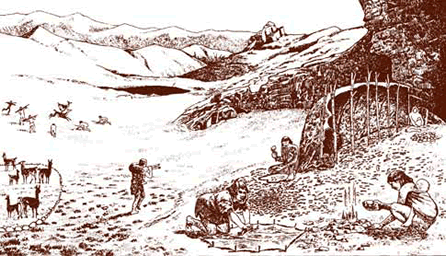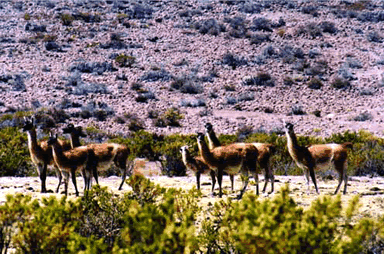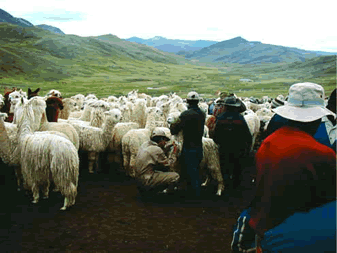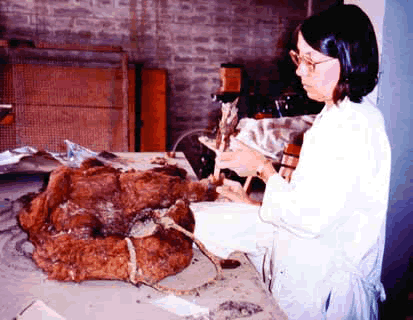By Jane C. Wheeler, Ph.D.
Conducting high quality scientific
research is always a difficult
undertaking in the best of
circumstances and although the
possibility of doing research in Peru
might at first consideration appear
impossible, it is not. Thanks to the
creation of a model camelid farm at La
Raya, Cusco in 1950, much basic
research on alpacas was carried out by
professors associated with what is
today San Marcos University’s
Veterinary Institute for Tropical and
High Altitude Research, IVITA.
Among the early IVITA publications
are the first scientific reports on alpaca
reproductive physiology, infectious
diseases, parasitology and nutrition, to
name but a few. An active alpaca
research programme was maintained
both at San Marcos’s Faculty of
Veterinary Medicine in Lima, and the
IVITA research center at La Raya with
support from the Rockefeller
Foundation and FAO through |
|
|
| |
MACS project: Recording weight of vicuña, Vicugna vicugna mensalis, at chaccu held at Catac, Ancash.
|
the
1970’s and, although largely attenuated
by the political and social upheavals of
the 1980’s and early 1990’s, the
tradition remains very much alive and
is actually undergoing a renaissance.
Thanks to a Senior Fulbright-Hays
Fellowship at San Marcos University in
the 1970’s my research focus shifted
from sheep and goats in the Middle East
to South American camelids in the
Andes. With degrees in Anthropology,
and a specialization in archaeozoology,
the study of animals in ancient societies,
the connection with the Faculty of
Veterinary Medicine and IVITA was
natural. A trip to La Raya, with its
research facilities, experienced staff and
extensive alpaca herds ventually led to
years of collaborative research on topics
ranging from determination of bone
fusion and dental eruption rates to the
study of ancient and modern herding
practices.
Over the years while working
at other institutions on the origin,
evolution and domestication of the
South American Camelids; molecular
genetics; breeding and fibre production;
as well as vicuña and guanaco
conservation, my ties with San Marcos
have remained strong and the Faculty of
Veterinary Medicine continues to be a
source of inspiration and research base.
In Peru the situation of both the wild and
domestic South American camelids and the
native Andean herders is precarious. Not
surprisingly, patterns of genetic variability
among the fragmented vicuña population
record the impact of near extinction and a
subsequent genetic bottleneck.
The high
elevation guanaco subspecies is both
virtually unknown to science and highly
endangered in Peru, where just over 3,000
animals survive today. Recent genetic
research has demonstrated that the domestic alpaca and llama descend from
the vicuña and guanaco respectively, and
have suffered from such extensive
hybridization that fewer than 10% of
alpacas and 60% of llamas remain pure.
Intentional cross breeding, to obtain
greater fiber weight and hence increased economic gain, has been general practice
during the last quarter century. As the
result, fiber quality continues to decrease,
threatening the livelihood of native
herders, as well as survival of the pure
alpaca.
The short term economic gains
obtained through hybridization, in
combination with other social, political
and economic realities, have produced a
crisis of major proportions that effects
everyone involved. Finding a solution to
these problems will not be simple and
obviously will require much more than just
helping the herders out. A central,
underlying cause is the devastating loss,
during the Spanish conquest, of ancestral
knowledge about conservation,
management and breeding of all four
South American camelids, knowledge
which can only be recovered through solid
interdisciplinary scientific research.

Reconstruction of life at Telarmachay
Rockshelter ca. 4,500 B.C. showing the ongoing process
of vicuña domestication. From Préhistoire des hautes
Andes : de la chasse à l’élevage. Pour la Science,
Edition Francaise de Scientific American 88:12-21.
Starting with the study of more than
one ton of animal bones excavated at
Telarmachay Rockshelter in the central
Peruvian Andes, where evidence of alpaca
origins from domestication of the vicuña
6 to 7,000 years ago was preserved,
through the study of 1,300 year old alpaca
and llama mummies from the site of El
Yaral in Moquegua which documented
the existence of highly selected breeds
prior to the Inca empire, my research has
progressed from simply studying the past
to trying to recover the magnificent
quality of the animals which existed prior
to the Spanish conquest – from bones, to
mummies to molecular genetics and
more. In the process, CONOPA, an
independent Peruvian institution,
primarily dedicated to scientific research
and development of the South American
camelid sector was established in 2001.

Darwin Initiative, GUANACO 1 project, Lama guanicoe cacsilensis
at Reserva Nacional Calipuy, La Libertad.
CONOPA is the name given by
traditional Andean herders to small carved
stone figurines which represent both the
domestic and wild South American
camelids. Most conopas have a small
depression on their backs, which
according to legend, represents the lakes
of the high Andean grasslands through
which alpacas came into our world on loan
from the mountain gods, and through
which they will return if humankind does
not take good care of them.

Sampling alpaca herd for DNA purity testing, Canchis Province, Cusco.
Others
represent vicuñas and guanacos, animals
which belong to the mountain gods.
Although manufactured up to the present,
conopas are of prehistoric origin and
continue to be used during ceremonies
carried out in order to insure the wellbeing
and multiplication of vicuña, guanaco,
alpaca and llama herds. As such, conopas
symbolize world of Andean herders, their
beliefs, their practices and the South
American camelids upon which they
depend. It is in this holistic sense that we
chose the name CONOPA and the phrase“cuidando los rebaños de los Apus” or“ taking care of the mountain god’s herds”,
for our institution. Our primary goal is to
utilize scientific research and education to
preserve biodiversity and the environment,
while respecting and learning from past
and present native cultures, in order to
improve the well being of traditional
Andean herders.
CONOPA is composed of camelid
specialists who have many years of
research experience, and extensive
publication records. Raul Rosadio, the
president, is a veterinarian who holds a M.Sc. in Veterinary Virology from Washington State
University and a Ph.D. in
Experimental Veterinary
Pathology from Colorado
State University. Jane C.
Wheeler, the vice
president, holds degrees in
Anthropology and
Archaeology from
American University,
Cambridge University and
the University of
Michigan. Hermelinda
Rivera, the secretary, is a
veterinarian who has
completed post graduate
training in diagnosis of
viral diseases at South
Dakota State University.
Domingo Hoces, treasurer,
is a biologist with post
graduate training at Peru’s National
Agrarian University La Molina, and one
of the foremost specialists in vicuña and
guanaco conservation and management.
At present, CONOPA is participating
in research projects on alpaca genetics,
sustainable utilization of the vicuña and
guanaco, and guanaco conservation and
population genetics in Peru. The first
project is financed by INCAGRO, Peru,
and has involved evaluation of the alpaca
population of Canchis Province, Cusco,
to determine the incidence of nonhybridized,
genetically pure animals and
the relationship of purity to fibre quality.
The second project is MACS, Sustainable
Management of Wild South American
Camelids funded by the European
Community. CONOPA is the Peruvian
partner in a major undertaking headed by
the Macaulay Land Use Research
Institute in Aberdeen, Scotland, and
composed of Euroean (Giessen
University, University of Norway,
Valencia University) and South American
(Catholic University Chile; Lujan
University, Argentina; and CONOPA,
Peru) partners. Our role in this project is to conduct research on vicuña genetic
variability and conservation in the Andes.

Jane C. Wheeler studying 1,300 year old llama mummy from the site
of El Yaral, Moquegua, Peru.
The third project is financed by the
Darwin Initiative of Great Britain and
carried out jointly with the University of
Cardiff, Wales. This project is a carryon
of a previous Darwin project on vicuña
genetics, but this time dealing with Peru’s
highly endangered guanaco population.
As with the previous Darwin project, it is
being carried out in collaboration with
Dr. Michael W. Bruford. Dr. Ciara Dodd
of Cardiff University holds the
postdoctoral post and Jorge Rodriguez
and Katherine Yaya (CONOPA) will have
received extensive training both at
Cardiff and in Peru before completion of
the project. This month has seen the
beginning of a new project designed to
establish DNA parentage testing for
Peru’s alpaca registry under a grant to the
Peruvian Nuclear Energy Institute,
Cayetano Heredia University and
CONOPA from the International Atomic
Energy Agency in Vienna.
CONOPA is also is actively involved in
research in areas other than molecular
genetics. Among the projects in animal health are studies of vicuña
reared in captivity
(Veronica Risco,
CONOPA, and Luis
Miguel Ortega Mora,
Universidad Complutense
de Madrid), enterotoxemia
vaccine development (Raul
Rosadio and Katherine
Yaya, CONOPA), alpaca
nutrition and fibre growth
(Juan Olazabal, CONOPA,
and Felipe San Martin,
Faculty of Veterinary
Medicine, UNMSM) and
accelerated reproduction
in alpacas, (Rosa Davalos,
CONOPA). Work also
continues on the study of
prehispanic camelids (Jane C. Wheeler, CONOPA)
and the preparation of a primary school
text book on the South American camelids
is underway.
In future issues of CQ, Jane C.
Wheeler will be writing about the
different research areas described above.
Although not a registered US nonprofit
organization, contributions to the
research efforts of CONOPA are
gratefully received.
CQ
About the Author
Jane Wheeler is Vice President for Research,
CONOPA (Coordinadora de Investigación y
Desarrollo de Camélidos Sudamericanos), Lima,
Perú, jwheeler@conopa.org. She holds degrees
from American University, Cambridge
University, and the University of Michigan, and
completed postdoctoral studies at the University of
Paris. For more than 30 years she has conducted
broad based research on the South American
camelids, covering topics from origin, evolution
and domestication of alpacas and llamas, to
molecular genetics, breeding and fibre production,
as well as vicuña and guanaco genetics and
conservation.
|
|
|
|
|
|
Guanaco 1
project logo |
Darwin Initiative logo,
financers of the
Guanaco 1 project |
Cardiff University logo,
identifying an
institutional participant
in the Guanaco 1 project |
CONOPA logo,
identifying an
institutional participant
in the Guanaco 1 project |
Incagro logo, identifying
an organization which
financed the research on
genetic purity of the
alpaca population in
Canchis Province, Cusco |
Logo of MACS, EU
financed project on
Sustainable Management
of Wild Camelids. See
www.macs.puc.edu.cl |
|

